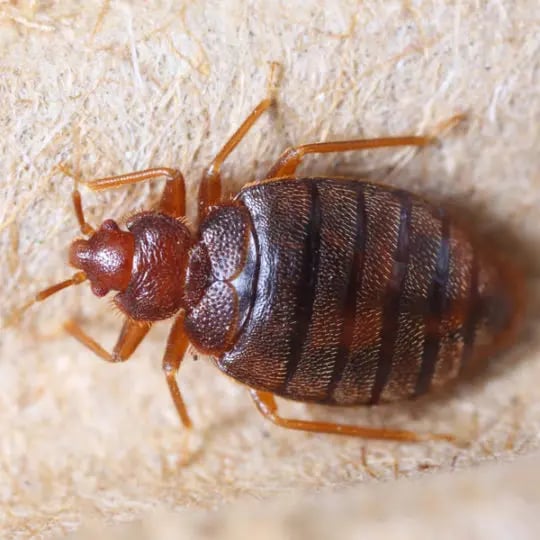Discovering the Scientific Research Behind Bed Bug Warmth Treatments as a Lasting Bug Management Strategy
In the world of insect monitoring, the quest for efficient and sustainable options remains a constant search. One such method that has actually obtained grip in the last few years is the usage of heat treatments to deal with bed pest infestations. By utilizing the scientific research behind thermal death points for these consistent parasites, heat treatments use an appealing choice to traditional chemical-based methods. The ins and outs of just how heat efficiently removes bed bugs and the wider ramifications for lasting parasite management practices make this a topic worth discovering even more.
Bed Pest Warmth Therapy Process

Thermal Death Factor for Bed Bugs
Revealing bed pests to raised temperature levels past their thermal resistance array is critical for attaining reliable obliteration in warmth therapy processes. By reaching and keeping temperature levels over the thermal death point for bed bugs, pest monitoring specialists can make sure detailed elimination of bed bug populaces, consisting of hard-to-reach areas where chemical treatments may be less effective. Understanding the thermal fatality factor for bed insects is vital for implementing effective warmth treatment strategies and achieving lasting insect management end results.
Advantages of Warmth Treatments
Having actually established the critical thermal fatality point for bed bugs, it is important to now discover the considerable advantages that warmth treatments supply in successfully eliminating these resilient insects. When contrasted to traditional chemical approaches, heat therapies present a number of key advantages. Among the primary benefits is that heat can permeate deep right into fractures and holes where bed pests hide, making certain that even the most hard-to-reach locations are heated to deadly temperature levels. This extensive technique not just kills real-time bugs however likewise targets bed bug eggs, protecting against future problems.
Furthermore, warm treatments are eco pleasant and safe, making them a lasting insect monitoring strategy. Unlike chemical pesticides, heat treatments do not leave damaging residues that can present dangers to human health and wellness or the setting. This facet is specifically vital in delicate settings such as hospitals, schools, and houses where chemical use might not be preferable.
In addition, warm treatments have a high success rate in eliminating bed bug infestations in a solitary therapy, minimizing the requirement for several check outs and reducing disruption to occupants. This performance not just saves money and time yet likewise offers satisfaction to those managing bed pest issues.
Effectiveness of Heat Therapy

Heat treatments have actually the included advantage of eliminating bed pest eggs, which are often resistant to conventional chemical treatments. Overall, the efficiency of warm therapies in getting rid of bed pest infestations makes them a sustainable and reputable bug administration method.
Lasting Bug Administration Conveniences
Carrying out sustainable insect management techniques uses long-lasting benefits for both the setting and public health and wellness. By using approaches such as warm treatments for parasite control, we her response can minimize the reliance on harmful chemical pesticides that can have adverse results on environments and human health - exterminator near me. Sustainable pest monitoring methods help in maintaining biodiversity by targeting particular parasites without hurting non-target organisms, thus preserving a balanced ecological community
Additionally, lasting insect monitoring methods add to the general health and health of the public. By decreasing exposure to poisonous chemicals used in standard pest control techniques, warmth therapies offer a more secure alternative for bug monitoring in domestic, industrial, and public rooms. This reduction in chemical usage also assists in preventing pesticide deposits from infecting air, water, and soil, protecting ecological top quality.
Conclusion
Finally, bed pest warmth treatments have been you can try these out shown to be a efficient and sustainable bug monitoring strategy. The thermal death point for bed insects makes them prone to warmth link therapies, which have many benefits over typical chemical therapies. The performance of heat treatments in eliminating bed bug infestations while reducing ecological impact highlights the potential of this method as a sustainable remedy for pest control.
The bed bug heat therapy procedure entails increasing the temperature within plagued areas to a level that efficiently eliminates bed bugs and their eggs. By reaching and maintaining temperature levels above the thermal death point for bed pests, parasite monitoring specialists can make sure detailed elimination of bed bug populations, including hard-to-reach areas where chemical therapies might be much less efficient. One of the primary benefits is that warmth can permeate deep into crevices and cracks where bed pests conceal, making sure that even the most hard-to-reach areas are warmed to dangerous temperatures. Unlike chemical therapies that might leave behind resistant populaces, warm treatments offer a environmentally friendly and safe service that can pass through deep into furnishings, walls, and other hard-to-reach locations where bed pests hide.
The thermal fatality factor for bed insects makes them vulnerable to heat treatments, which have numerous advantages over standard chemical treatments.